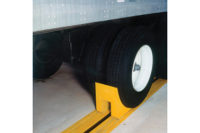Safe City Driving Practices
Driving in cities presents its own set of unique challenges. It can be unpleasant, stressful, upsetting and even dangerous. Drivers’ attention, concentration, reactions and awareness are tested as they face constant hazards.
Motor vehicles of all shapes and sizes, bicycles and
pedestrians are all competing for space on narrow, congested streets, often
with impaired visibility. At the same time, there are endless traffic
signals, signs, rules, speed zones, detours and all types of street work
and repair.
Nevertheless, there are measures a driver can take to
ensure a safe and less frustrating trip, according to traffic and safety
professionals, and it all begins with planning.
They advise that dispatchers and drivers plan their
routes ahead of time and make sure they are aware of any truck routes,
trucks-prohibited roads or planned road closures or construction. It is not
safe to be reading a map or a navigation aid while driving in what is
usually heavy city traffic.
Professionals recommend that drivers stay alert,
concentrate on driving and minimize unnecessary distractions in their
vehicles, such as turning down the radio. Being able to hear what is going
on around them can be a big asset to driving safely.
Drivers should not use a cell phone while driving,
even a hands-free model. The fewer the distractions, the better a driver
can concentrate on safely maneuvering his vehicle, say traffic and safety
professionals.
Traffic laws, traffic control devices and speed limits should be obeyed and a safe
following distance kept. The amount of space needed to safely come to a
stop increases the faster one drives. Traffic and safety professionals
point out that driving too close to the vehicle in front is one of the most
common causes of accidents in cities.
They also caution against insisting upon driving
rights when it may lead to an incident. An example of this is a four-way
stop: even if it is your turn to go and another driver goes as well, let
him, say the professionals. Patience can often avoid an incident, traffic
and safety professionals note.
When driving in cities, whether large or small,
traffic and safety professionals urge drivers to be alert for:
Schools — Drive
slowly, even if the school zone warning lights are not flashing. Be extra
vigilant for children who may run across the road without looking.
Pedestrians or bicycles —
They, too, may dart out into traffic without warning.
Alleyways, driveways and parking lot exits — These areas require extra caution as they may
be hidden from view and vehicles may appear suddenly.
Construction and resulting
detours — Normal speed limits may be
reduced, traffic lanes and flow may be changed and people and vehicles may
be working on or near the road.
Drivers should get in the practice of scanning the
roadway ahead, about a block or two further on, say safety and traffic
professionals, keeping any eye out for potential traffic problems and being
prepared to react. The danger in not looking far enough down the road, they
warn, is that a driver might miss seeing slow or stopped vehicles ahead of
them, or a pedestrian crossing in mid-black, until the last moment.
Drivers should try to anticipate the actions of other
drivers but never presume they know what another driver or pedestrian will
do, the professionals add. And do not rely on traffic directions from others.
Drivers should give other drivers warning of their
movements by appropriately using turn signals and flashers. These attract
the attention of other drivers and reduce the chance of accidents, note
traffic and safety professionals. Driving with the headlights on also helps
ensure other drivers see your vehicle.
Traffic and safety professionals advocate that drivers
keep their eyes constantly moving up and down the road and side to side,
and to check their mirrors frequently. A driver should always know what is
going on behind his vehicle and on the sides so there are no surprises,
they stress. The windshield, windows and mirrors ought to be kept clean for
good visibility.
The horn should be used in emergency situations only
as it might startle other drivers, causing them to make a sudden or unsafe
move.
As with any type of driving, drivers can reduce their
chances for traffic incidents while driving in cities by applying safe
driving practices. According to traffic and safety professionals, the
majority of all traffic incidents may be attributed to human errors. So
tell your drivers to plan their routes, concentrate on their driving, avoid
distractions, be prepared for the unexpected, have patience and use common sense.
Traffic circles
Traffic circles, sometimes referred to as roundabouts,
are used to reduce accidents, traffic delays, fuel consumption, air
pollution and construction costs, while increasing capacity and enhancing
intersection beauty.
Here are some tips to share with your drivers for
safely entering and driving through them:
As you approach, slow down and be prepared to stop if necessary.
Check the traffic control signs at the entrances to the traffic circle to determine who has the right of way.
When you enter, yield to circulating traffic but do not stop if the way is clear.
Use your turn signal and go off at your exit.
As you approach, slow down and be prepared to stop if necessary.
Check the traffic control signs at the entrances to the traffic circle to determine who has the right of way.
When you enter, yield to circulating traffic but do not stop if the way is clear.
Use your turn signal and go off at your exit.
When in doubt about who has the right of way, traffic
and safety professionals say drivers should exercise extreme caution and
remember the basic rule governing any uncontrolled intersection: the
vehicle to the left shall yield the right of way to the vehicle approaching
from the right.
Equipment news roundup
ArvinMeritor is
dropping its line of Meritor branded fully manual truck transmissions and
focusing on its FreedomLine of automated manual transmissions, produced by
Germany’s ZF Friedrichshafen (ZF). However, all Meritor manual
transmissions will continue to be supported by the company for an
“extended period of time.”
International Truck and Engine has updated its 8600 model regional-haul tractor with a
variety of new features, including on-board tire and battery monitoring
technology, along with other electronic functions such as a parking brake
alarm, automatic windshield wiper speed control, pre-trip exterior light
inspection and a theft-deterrent system.
Kenworth, for the second
year in a row, achieved the highest ranking in customer satisfaction among
Class 8 truck owners in the Pickup and Delivery, Over The Road and Dealer
Service Segments, according to the J.D. Power
and Associates 2006 Heavy Duty Truck Customer Satisfaction Study. The study includes responses from 2,529 primary
maintainers of two-year-old Class 8 heavy-duty trucks and also measures
satisfaction with services received from an authorized truck dealer’s
service department. Customer satisfaction for the three product segments is
measured for four factors: performance, quality, warranty and cost of
ownership.
David Kolman is a veteran truck communicator, keynote
speaker and long-haul trucker. Commissioned as an Honorary Colonel on the
Kentucky governor’s staff for his work promoting traffic safety, he
actively participates in trade associations and reports news and
information about the trucking industry for broadcasting and print media.



